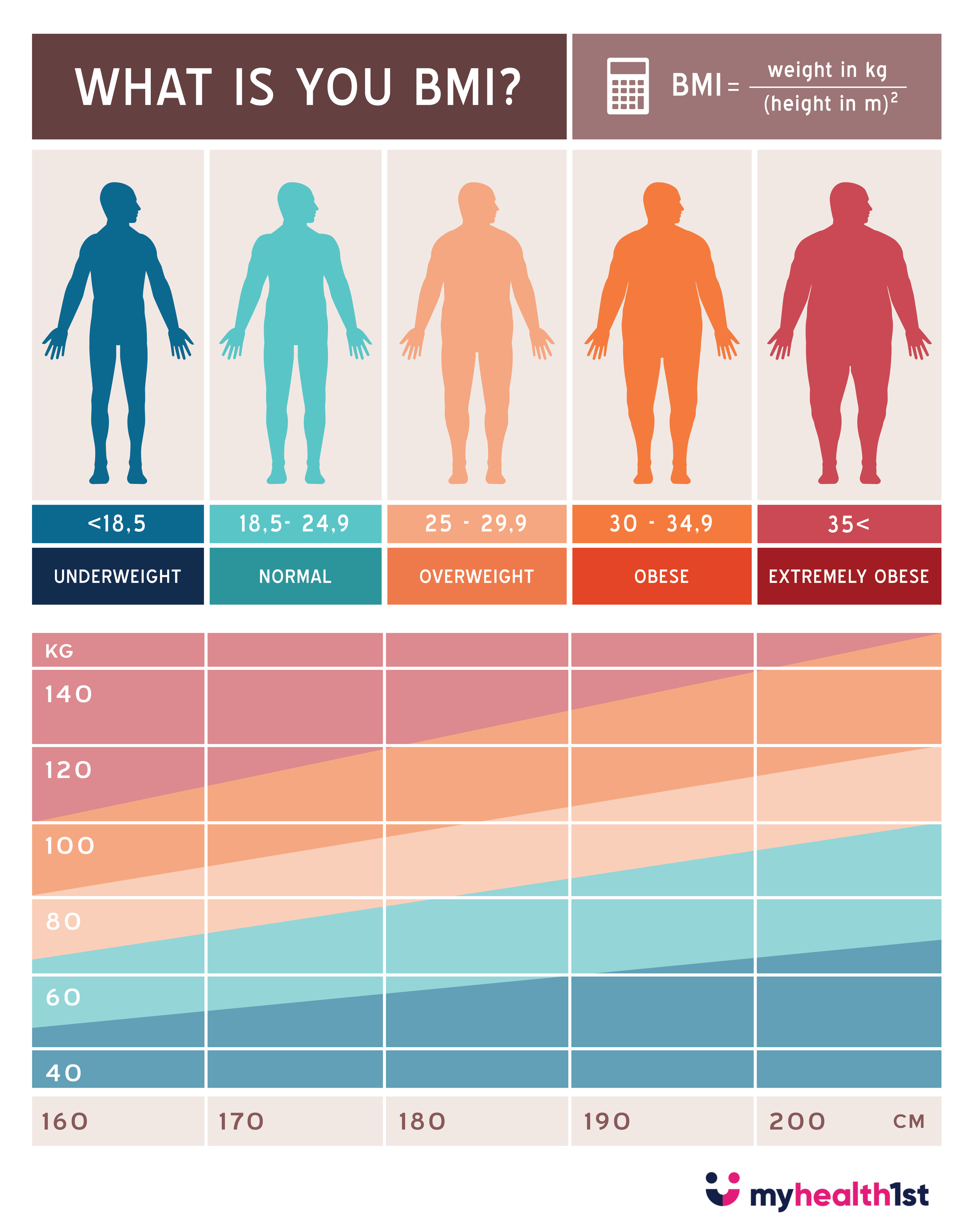
At a glance:
- BMI is a simple calculation dividing a person’s weight by their height in metres squared to determine whether they fit within a healthy weight range
- Healthy BMI varies by age, sex and racial background
- A BMI of around 18.5 - 25 kg/m² is generally considered healthy
- BMI under 18.5 kg/m² is generally considered underweight
- BMI between 25 - 30 kg/m² is considered overweight and anything over that limit is categorised as a level of obesity
- While BMI can be used as an indicator of overall healthy weight, a waist measurement is generally a better indicator of potential health risk
What is BMI?
The Body Mass Index, or BMI is a value derived from a person’s height and weight intended to determine whether a person is in a healthy weight range for their height.
The idea of BMI was first developed between 1830 and 1850 by Belgian polymath Adolphe Quetelet, a mathematician, statistician, sociologist and astronomer. The idea was further expanded on by physiologist Ancel Keys and a team of researchers for a paper published in the 1972 Journal of Chronic Diseases. Keys was the first to coin the term Body Mass Index, but never intended the calculation to be used for individuals.
The research that Keys and his team were conducting looked at the increasing prevalence of obesity in prosperous Western counties, and as such Keys believed that the calculation for BMI was only truly applicable to entire populations, not individual cases.
What is BMI Used For?
Due to the simplicity of the calculation, BMI has become one of the go measurements for weight issues. It is a clear, but not necessarily an highly accurate way to illustrate that a person may have weight issues and to help them maintain a healthy weight.
The calculation divides the person’s weight in kilograms by their height (in m²) to determine the overall range in which they fit, with the higher someone’s BMI the more at risk they are of health issues or complications due to weight.
What is a Healthy BMI?

Healthy BMI varies between racial groups, sexes and ages, but as a rule of thumb, a healthy BMI is one that is between 18.5 and 25 kg/m². Anything under 18.5 kg/m² is considered to be underweight, and on the other end of the scale, anything over 25 kg/m² is overweight and 30 kg/m² is classified as varying levels of obesity. Both being underweight and overweight or obese are risk factors that can lead to health issues and complications.
Underweight
Being underweight (under 18.5 kg/m²) can be an indication of malnourishment and can also lead to other complications including:
- A compromised immune system leading to a higher susceptibility to infection
- Respiratory disease including chronic obstructive pulmonary disease (COPD), respiratory infections and asthma
- Digestive diseases (diseases such as Crohn’s and Ulcerative Colitis may also be a cause of malnutrition)
- Cancer
- Osteoporosis
- Fertility issues
- Irregular menstruation
- Anaemia
Overweight
People with a high BMI (of 30 or more) have a higher risk of developing a number of health conditions than people with a healthy weight, including:
- Type 2 Diabetes or Insulin Resistance
- High blood pressure (hypertension)
- Sleep apnoea (problems breathing while asleep)
- Gallbladder disease
- Cardiovascular diseases such as stroke or myocardial infarction (heart attack)
- Breathlessness
- Some forms of cancer, most notably breast, colon and endometrial cancers
- Fatigue
- Gout
- Osteoarthritis
- AMD (Age Related Macular Degeneration)
- Respiratory diseases including asthma and Chronic Obstructive Pulmonary Disease (COPD)
- Reproductive and fertility issues
- Polycystic ovarian syndrome
- Skin complications
- Cataracts
- Varicose veins
- Musculoskeletal problems, especially back issues
- Oedema/cellulitis
Excess weight may also lead to issues with depression and self isolation.
The easiest way to find a doctor is to search and book online with MyHealth1st .
Limitations of the BMI Calculation
The simplicity of the BMI calculation means that it cannot take into account a number of variables that can lead to an incorrect rating. Simple BMI calculation doesn’t take into account the difference between muscle and fat, so someone with a great deal of muscle mass may be classified as obese, or someone who has lost muscle mass due to injury, illness or age can be classified as dangerously underweight even if they are healthy.
A recent large meta-analysis of 2.9 million people from 97 different trials demonstrated that over the age of 50, a BMI between 25-30 had a 6% lower death risk compared with BMIs in the lower range or above 30.
BMI varies by age, sex and racial background, so calculations need to be compared to those in the same demographic to obtain a more accurate measure. Pregnant women also have a significantly higher BMI due to non-fat weight gained through pregnancy. The calculations also do not take into account the distribution of fat. People with more fat around the midsection are generally more at risk of health complications due to weight than those with fat distributed around the hips.
BMI is not practical for measuring childhood obesity either, as growing children are in a state of flux when it comes to height and weight.
As such BMI isn’t always the best indicator or measure of health or the potential risks that come with weight. A measure of waist circumference is usually a better indicator of potential health risks as having a round or “pot” belly appears to indicate an elevated risk of health complications, regardless of overall weight.
If you’re worried about your weight, before you launch into any diet or exercise plan, see a doctor or get their advice or a referral to a dietician or nutritionist. Together you can make a safe and effective weight loss (or gain) plan.